Journey of Juxtapositions
Skelly: Thinking through Brancusi and Penone by
Sandra Percival
Invited by Adams and Ollman to write about artist Vince Skelly’s exhibition and new work, the exchange below is part provocation and part conversation on the work and practice of two modern/contemporary artists—Constantin Brancusi and Giuseppe Penone—as a way of thinking about and contextualizing Skelly’s work.
Part I
The Work of Art & the Artist’s Studio: Constantin Brancusi
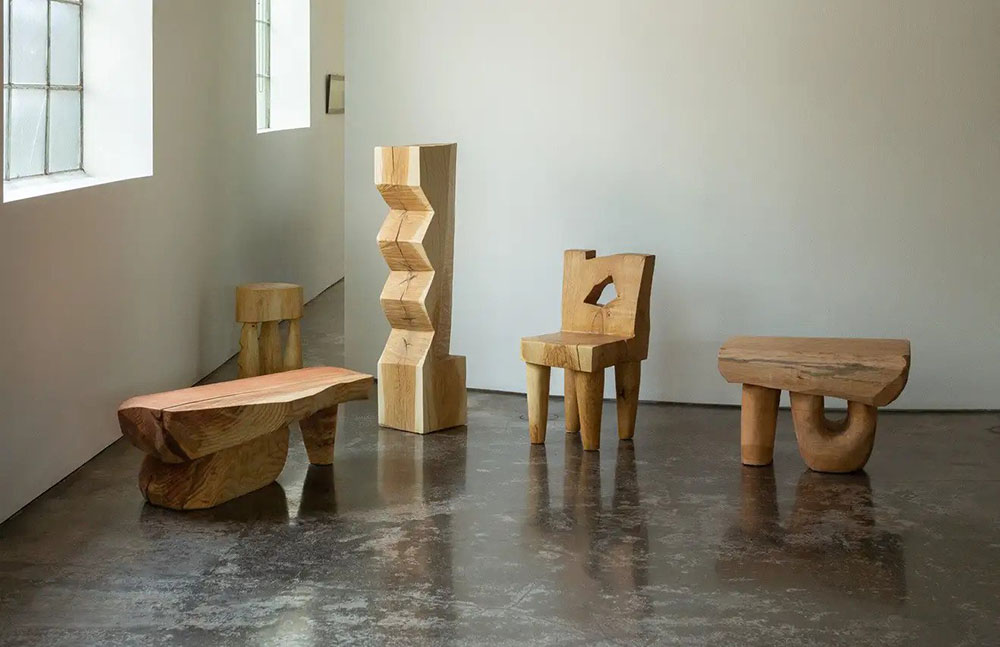
Vince Skelly works in situ, 2020
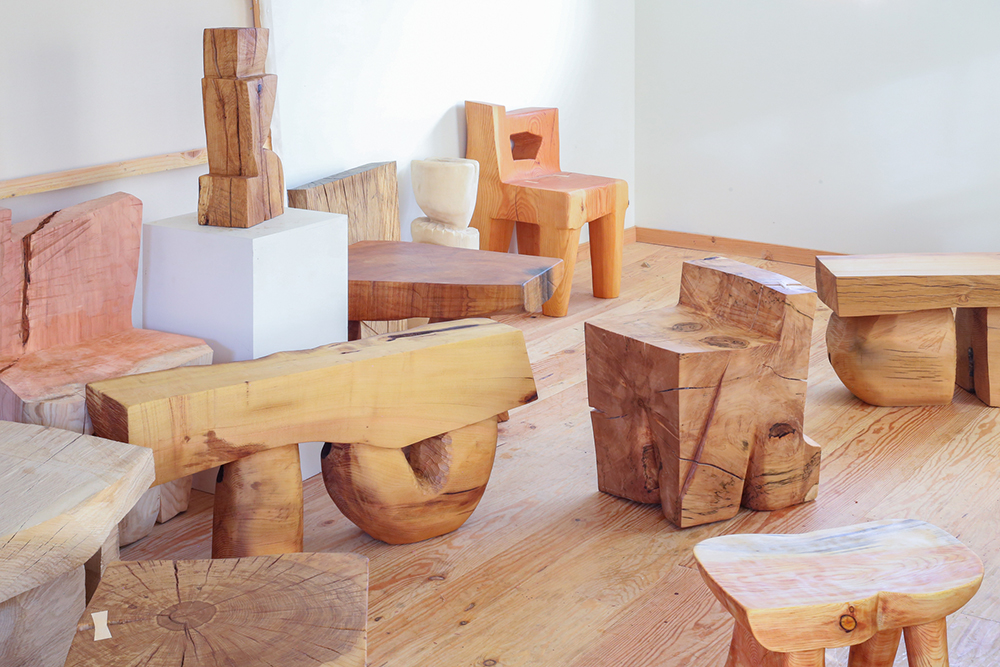
Vince Skelly studio, 2021
Adams and Ollman’s first introduction to Vince Skelly was an image of an arrangement of Skelly’s works in his studio, one work of which called to mind Constantin Brâncusi’s Endless Column. While a series of Skelly’s works were differently arranged at Adams and Ollman in Vince Skelly: New Works on view February 12—March 13, 2021, Brâncusi becomes the focus to think about an artist’s relationship to their studio as a space for thinking and making, and potentially, the studio in its entirety as a work of art in and of itself.
Early in his life, Brancusi had an aptitude for wood carving seen in early stacked columnar and totemic-like sculptures, and in the mid-1910s, he made works such as Chien de garde (Watchdog, 1916) from salvaged oak beams, reflecting a “primitivizing” influence. Brâncusi’s Endless Column (15 stacked rhomboidal modules) is part of a triptych of works along with the Table of Silence (a circular stone table surrounded by twelve hour-glass seats) and The Gate of the Kiss which comprise Brâncusi’s 1938 World War I monument in Târgu Jiu, commemorating the sacrifice of Romanians who fought against the forces of Central European Powers in 1916. Situated on a 1.3km (3/4 mi) long axis and oriented east to west, Brâncusi’s monument stands as his magnum opus.
Beyond the similarity in form evoked in comparing a hand-carved column or sculpture by Vincent Skelly with Constantin Brâncusi’s work, how do we think of an artist’s studio with a changing array of works as a “gesamskunstwerke” or total work of art? Seeing a smaller version of Brancusi’s Endless Column set in his studio, led me to search further as to how Brâncusi thought about and used his studio and the works within it, as a way to elicit Skelly’s relationship to his studio. One studio—Brâncusi’s atelier near rue Rombuteau was rebuilt several times in 1936 and 1941 and is now set within the grounds of the Pompidou Center built in 1971 in urban Paris, while Skelly’s studio is set in his backyard in the urban landscape of Southeast Portland, Oregon in the Pacific Northwest, United States.

Colonnes sans fin (Endless Columns), Brâncusi’s studio, 1925
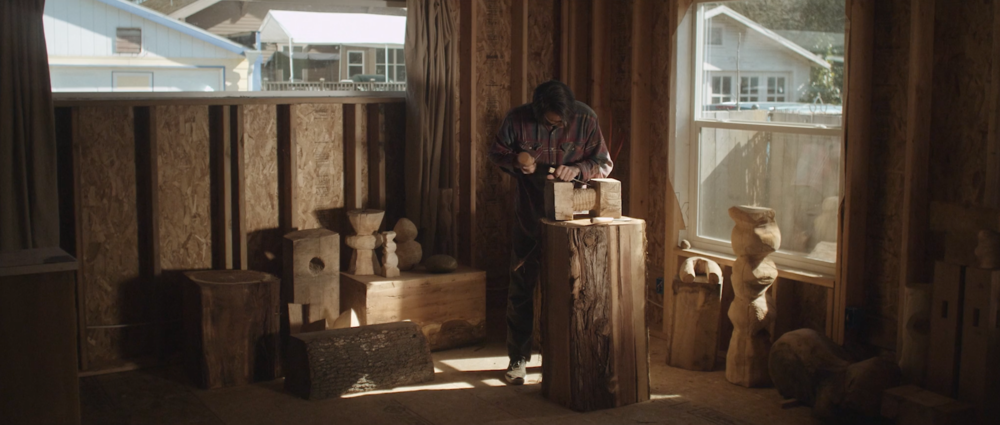
Skelly working in the studio, 2019
Constantin Brâncusi (1876-1957) came from a poor Romanian peasant background where his family labored in the fields near the Carpathian Mountains in eastern Europe. Brâncusi herded sheep and, as an eighteen-year-old lover of music, he created his own violin which led him to enroll at the Craiova School of Arts and Crafts where he studied woodworking, graduating in 1898. He then studied sculpture at the Bucharest School of Fine Arts, and later at the Ecole des Beaux-Arts in Paris from 1905 to 1907. He arrived in Paris in 1904 at the moment of the Parisian avant-garde of the 1910s and 1920s amidst a coterie of artists including Modigliani, Picasso, Bourgeois, Duchamp, and Leger. Over the years, the influence of his Romanian peasant roots persisted; his house and studio were filled with rough-hewn furniture in wood and stone.
From 1916 until his death in 1957, Brâncusi’s various studios were used for works in progress and to house his workbench and tools. Brâncusi, in all his work—whether in a gallery, museum, or a landscape—considered the relationship between his sculptures and the space they occupied to be crucial. By the 1910s, Brâncusi began laying out and arranging his sculptures in close spatial relationships in the studio which he called “mobile groups” considering the connections between the works themselves and the possibilities of each for moving around within the group. In the 1920s, the studio itself became an exhibition space and a work of art in its own right—a “gesamskunstwerk”—or, as Brâncusi called it, “a body consisting of cells that all generated each other.” At the end of his life, Brâncusi stopped creating sculptures and focused solely on their relationships within the studio. While no longer exhibiting, when he sold a work, he replaced it with a plaster copy in the studio so as not to destroy the unity of the group.
Part II
The Work of Art & the Artist’s Material and Method: Giuseppe Penone
After Brancusi, I thought about artists whose work would also provoke thinking about Vince Skelly’s sculptures. First, Martin Puryear who, similar to Brancusi, raised issues of labor, craft, woodworking, and also race. However, I kept thinking about Skelly’s use of wood as his sole material and his practice of carving each object from a single block of a tree. In my Skelly file was an Artforum ad for a 2011 Giuseppe Penone, Haunch of Venison London exhibition—a full-page image of a section of a tree revealing its rings and carved out shapes and markings. Penone supplanted Puryear and became the focus to think about an artist’s relationship to, and use of, trees as a natural material for an array of objects and manners of making.
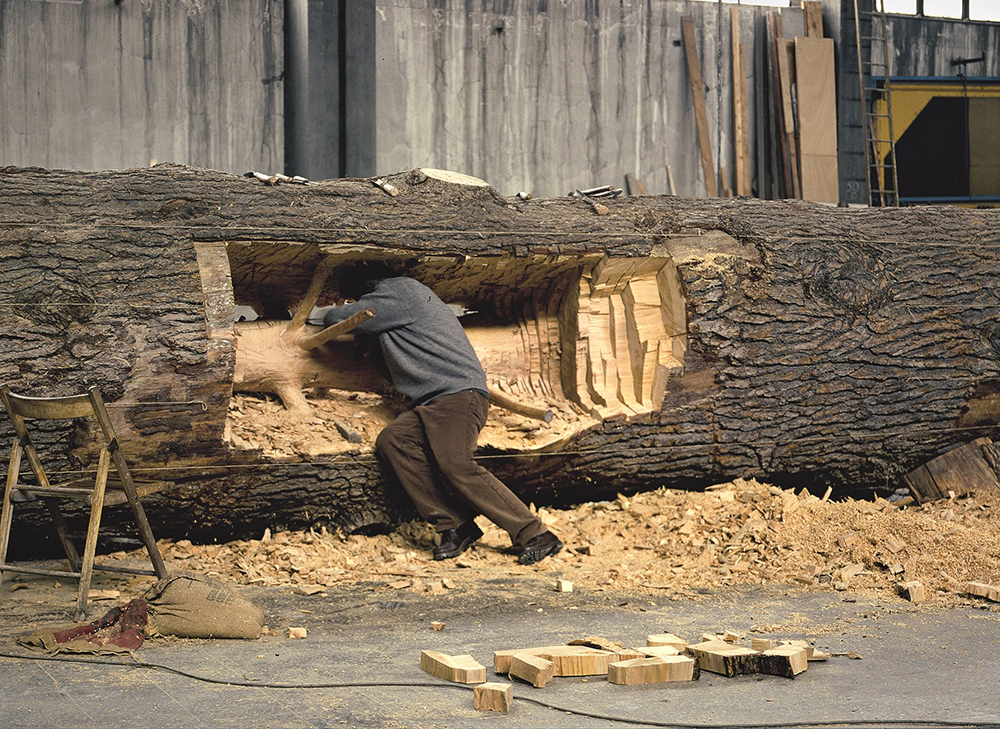
Giuseppe Penone working on Cedro di Versailles (Cedar of Versailles) (2000–03) in Turin, 2000. Photo: © Archivio Penone
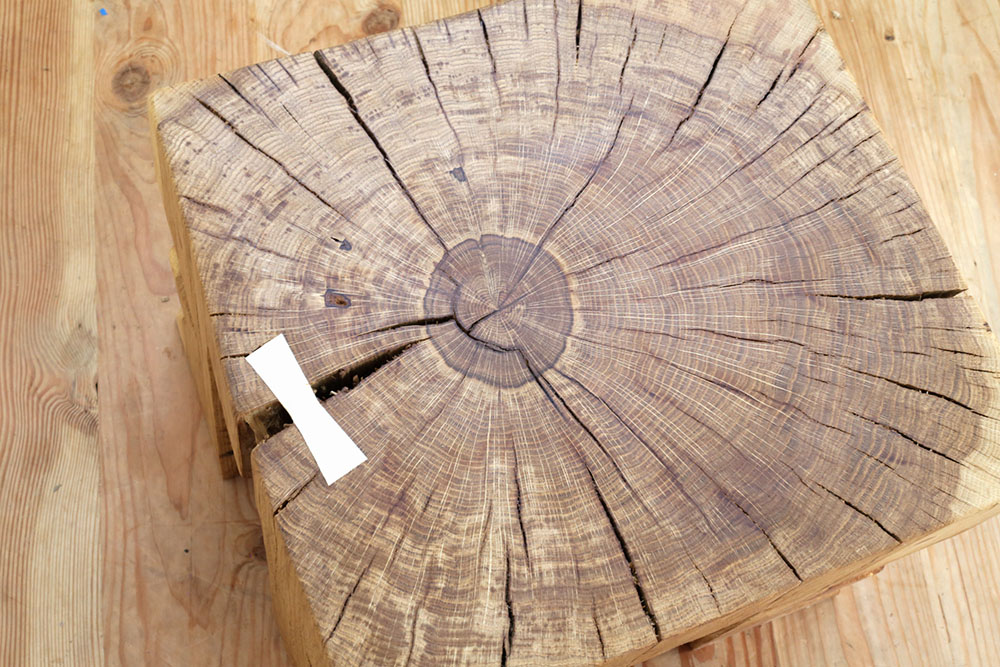
Vince Skelly, Dakka (detail), 2021
Skelly’s works reveal the chainsaw and carving gestures which erode a single block of wood—often native to the Pacific Northwest—to form his sculptures. Assembled together in the gallery at Adams and Ollman, Skelly’s works were laid out as if awaiting guests to sit, converse, or pause in silence. Strangely, they do not assert a scale for human use, perhaps revealing one of Skelly’s influences: The Flintstones’ prehistoric “midcentury-modern/caveman vibe.” While Skelly’s objects echo domestic forms of primitive tables, stools, and lintels, Penone’s works are rooted in the tree itself. In 1968, Penone wrote “I feel the forest breathing, and hear the slow, inexorable growth of wood.” In his search to reveal nature’s vital processes, he says “In a tree, there isn’t a single useless branch. That means the tree is a perfect sculpture.”
Giuseppe Penone’s 1968 Alpi Marittime (Maritime Alps) exists as a photographic work documenting six actions carried out by Penone in the Garessio forest in which he performs small gestures that interfere with natural elements. Penone’s attraction to natural materials and his corporal approach to art, influenced by the theatre of Jerzy Grotowski, caught the attention of Germano Celant (1940-2020). In the 1960s, critic, curator, and theorist Celant defined an attitude and an era. Nourished by the anti-establishment sentiment of the late 1960s when artists were taking a radical stance against the values of established institutions, Celant curated an exhibition of five young Italian artists—Alighiero Boetti, Jannis Kounellis, Luciano Fabro, Giovanni Anselmo, and Giuseppe Penone—who made work using humble materials and simple everyday objects including melted wax, rusting iron, fallen leaves, ground coffee, even horses munching hay. In his 1967 manifesto Arte Povera: Notes for a Guerilla, and his 1969 book Arte Povera, Celant states “each of these artists has chosen to live within direct experience” and “feels the necessity of leaving intact the value of the existence of things.”

Giuseppe Penone, Tra Scorza e scorza (Between Bark and Bark) installed at Château de Versailles, 2013. Photo credit: © EPV/ Thomas Garnier and © Tadzio.
Giuseppe Penone was born in 1947 in the Piedmontese village of Garessio, Italy, the son and grandson of farmers. He went to Turin in the late 1960s to study sculpture at the Accademia Albertina, which he left after only one year. Rejecting academia, Penone sought to embrace natural materials and search out methods he could relate to, saying “not having culture, not being knowledgeable about art, the only reality and identity I had was that of the place where I’d been born.” He started working in the woods around Garessio where he performed a series of experimental pieces in which saplings and streams became the protagonists of his work. Today, Penone’s villa and 16-hectare estate in the mountains outside of Turin is surrounded by a forest of greenery. Penone’s studio is a cavernous warehouse with the vast trunk of a conifer, various tools for sawing and carving, and industrial machinery for moving large objects. An adjacent annex holds works which are in the process of being prepared for exhibition. Both spaces smell of wood/timber.
In 1969, Penone made his first Albero (Tree) work by carving into mature timbers and removing the wood along the outer growth rings to reveal the sapling at the core of the trunk which he called “a memory.” On display, the delicate sapling, set upon a plank of the tree, is propped at an angle from ceiling to floor. In 1970 to museum audiences, he twice performed Albero di dodici metri (Trees of Twelve Metres), scraping away the wood from a felled tree, which he’d first roughly sawn into a beam, to reveal its internal structure of developing branches. The pair of 12-meter saplings emerge from wooden blocks, standing between the ceiling and the floor.
In 2004, similar to earlier Alberi (Trees) but at a much larger scale, Penone bought a 194-year-old storm-felled Cedar of Lebanon from the forest surrounding the Parque de Versailles to create his totemic Cedrodi Versailles (Cedar of Versailles) where he hacked away at the trunk of the tree, excavating the growth rings to reveal the sapling inside. The sapling stands within the void of the massive bark-covered, hallowed out trunk of the tree. Ripetere il bosco (Repeating the Forest) (1969-1974) assembles “a forest” of Penone’s Alberi—industrially cut blocks of timber shaped back into their natural state, from fragile, wisp-like branches to monumental trunks, which stand in a grove as if found in nature. In 2011 to create The Hidden Life Within, Penone stated that by carving out a younger tree from within a massive tree to reveal how it changed with years of growth was making visible natural processes which are normally hidden, ones which compel us to think about the concept of time. In 2019, Penone created an ever-finer rendering of a tree, this time with a 100-year-old conifer from the Valle des Merveilles in the Alps. Splitting the tree lengthwise, he gouged out the inner core to extract the growth rings, presenting it as Matrice di linfa (Sap Matrix)—a 43-metre-long monumental sculpture propped horizontally, like a canoe, by its branches on a “carpet” of the splayed off sheets of bark.
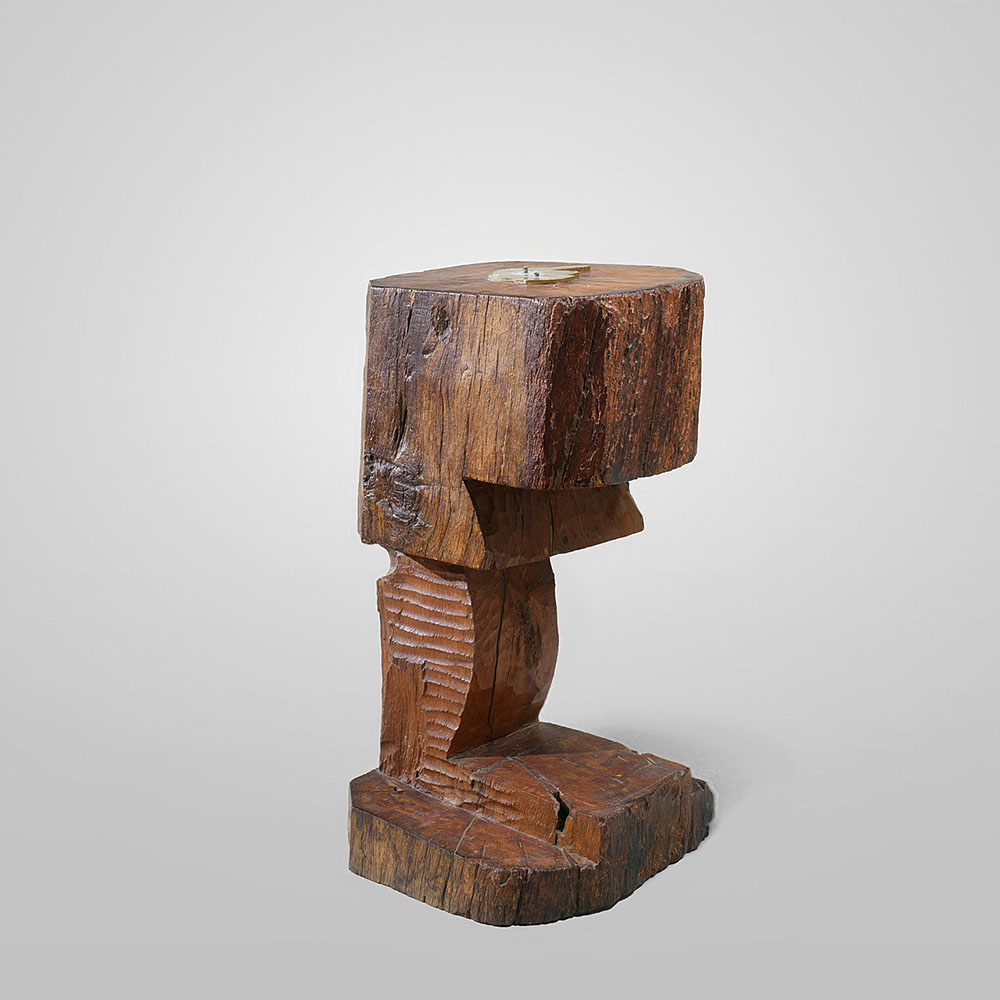
Constantin Brancusi, Chien de garde (Watchdog), ca. 1924, Copyright
© 2018 Artists Rights Society (ARS), New York / ADAGP, Paris

Vince Skelly, Filitosa, 2020
The journey could go on… to delve deeper, a further juxtaposition with Skelly’s as well as Penone’s oeuvres most recently came into view with a picture in Bookforum (Summer, 2020) of 94-year-old self-taught artist Thaddeus Mosley’s Geometric Plateau, 2014, walnut, cheery, 94 x 70 x 24”. He lives in Pittsburgh and cites Brancusi as an influence.
Recommended Reading: Overstory by Richard Powers, Winner of the 2019 Pulitzer Prize for Fiction
Sandra Percival is Founding Director and Curator of Zena Zezza in Portland, Oregon, presenting artist project seasons which include an exhibition and series of performative dialogues events. Since 2013, project seasons have included Josiah McElheny, Anthony McCall, Stan Douglas, Chantal Akerman, Hans Coper, and Shanghai-based artist/filmmaker Yang Fudong, fall 2021. Over four decades—from Seattle to London to San Francisco and returning to Portland, her hometown—Percival has curated and produced artists’ research/laboratory projects, exhibitions, and commissioned new work and multi-year public projects. Prior positions include Washington State Arts Commission, Public Art Development Trust, and New Langton Arts. In Seattle, she commissioned Jenny Holzer’s first permanent work; in London, Roni Horn’s Another Water for the “Thames and Hudson Rivers Project,” and, in the Bay Area, co-curated a retrospective of Lynn Hershman Leeson and commissioned Albanian artist Adrian Paci’s film Centro di Permanenza Temporanea. Participatory projects include OPENrestaurant, an event in Langton’s annex with artists, cooks, farmers, and activists, and in Portland to reenact “In the Spirit of Jean Dupuy’s 1974 Soup & Tart,” Percival cooked pistou soup for one hundred guests followed by forty artists’ two-minute performances. Percival was awarded an NEA Museum Fellowship and has lectured and participated in national and international conferences in the US, UK, Europe, Mexico, Brazil, and Australia. She taught in the MA in Curatorial Practice program at California College of the Arts, and served on University of California San Francisco’s Art Board, Mission Bay. Percival was a contributor to Camera Obscura, Feminism, Culture, and Media Studies “On Chantal Akerman” (2019).